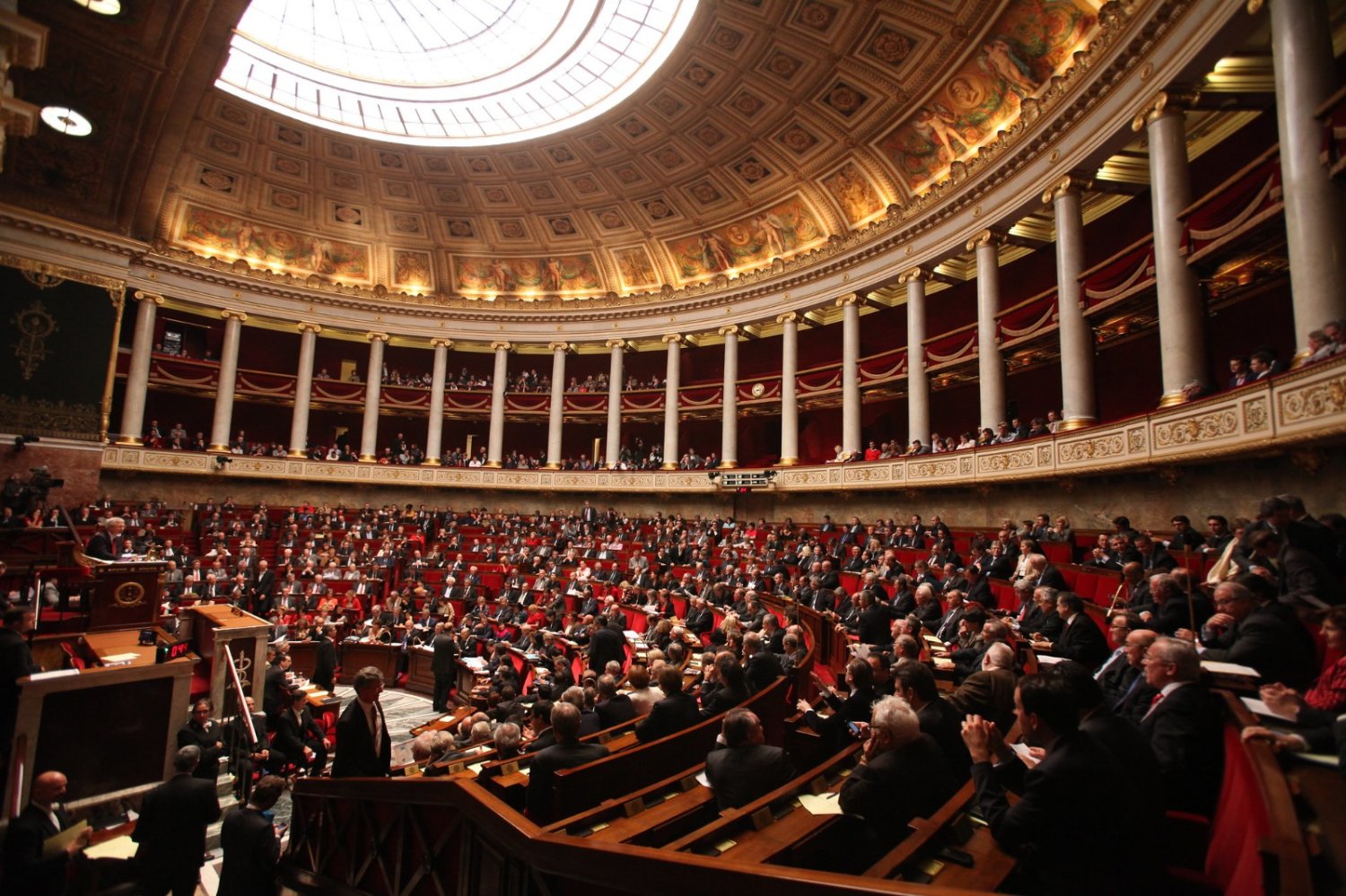
After the first round of the legislative elections on Sunday, June 30 in France, where the far-right National Rally [RN por sus siglas en francés] won a historic victory with 33.15% of the votes cast, coming first in 297 constituencies, and the idea of a “Republican front” to “stop the far right” in the second round was put at the centre of the debate.
In France, all candidates who have obtained more than 12.5% of the votes go to the second round. This means that in many cases the second round is not contested between just two candidates but between three or four.
Hence, this “Republican Front” is the tacit agreement reached by the centre-left of the New Popular Front (NFP) with the right-wing coalition “Together” of Macron, and even with the traditional right of The Republicans, to demote their candidates who have come in third or fourth place, and that in this way it is only one candidate from one of these forces who competes with the candidate of the extreme right of RN.
In practice, this meant that 220 candidates withdrew from their candidacy for the second round. Of these 220, 131 were candidates of the New Popular Front. [que agrupa al Partido Socialista, al Partido Comunista, a los verdes y a La Francia Insumisa-LFI de Jean Luc Mélenchon] and 82 from Macron’s camp.
This is enough to cast doubt on the prospect of an absolute majority for the RN, while paving the way for a “grand coalition” government scenario. [que puede incluir al NFP, a la agrupación de Macron y otras fuerzas menores), sin que sea posible predecir con certeza el resultado del domingo.
Abstención y frente republicano: las grandes incógnitas de las elecciones
La primera incógnita es la traducción que pueda tener la conformación de este “Frente Republicano” en las urnas. Si en menos de dos días los aparatos del NFP y de Macron acordaron la “gran retirada”, para bajar a sus candidatos, queda por verse la eficacia que realmente pueda tener la transferencia de votos a favor de los candidatos opuestos a la Agrupación Nacional. Esto es un punto que a un día de la elección no está claro.
Como lo resume el director de investigación de Sciences Po Luc Rouban para Public Senat, puede que algunos votantes de centroizquierda que no querían a La Francia Insumisa (que es el sector más de izquierda) dentro del Nuevo Frente Popular terminen por abtenerse si tuvieran que votar por un candidato de LFI. Por otra parte entre los votantes de la derecha tradicional de Los Republicanos puede que tampoco quieran votan en una segunda vuelta entre LFI y RN. Por último, los macronistas podrían negarse a apoyar a un candidato de izquierda que a futuro pondrá en dificultades al Presidente de la República.
La cuestión es si el frente republicano, que no es nuevo sino que aparece como expresión de la políitca del mal menor ante la amenaza de la extrema derecha y que se ha desmoronado significativamente en los últimos años, se revitalizará o no, y en qué medida.
Sobre este tema el instituto encuestador IFOP apuesta por el éxito de la operación para salvar el Frente Republicano. En el caso de una segunda vuelta que enfrente a un candidato ambientalista o socialista contra uno de RN, el 77% de los votantes de centro que decidan votar -excluyendo la abstención- elegirían al oponente de RN y sólo el 23% optaría por el partido de extrema derecha. En el caso de una candidatura de Francia Insumisa, sería más bien un 66% a favor y un 34% a favor de RN. En coordenadas opuestas, al oponer un candidato del Ensemble [Juntos, de Macron] In the case of an RN candidate, left-wing voters would be even more effective in blocking the election. Thus, 84% of the NFP electorate would vote for Ensemble and only 16% for RN. However, the electoral institute does not predict the future abstention rate.
However, these data are crucial to consider the different possible scenarios, as Erwan Lestrohan, director of consultancy at the Odoxa polling institute, points out: “If many unknowns remain, turnout is certainly the blind spot of most polls, with few institutes taking the risk of giving a figure. However, voter mobilization will certainly be a crucial factor in the final results.” In its own survey, the Odoxa institute accurately measured these data and counts on a low abstention rate due to this RPF policy. In its report, it notes that: “64% of NFP voters and 49% of Renaissance voters voted in favour of the vote.” [el principal partido de la coalición de Macrón] They claim that these withdrawals encourage them ‘even more’ to vote for a political opponent and against the RN. On the other hand, he also points out that the blockade encourages RN supporters to mobilize even more in its favor.
Another fact must therefore be taken into account, that of the 30% of abstentionists in the first round, which could be a reserve of votes for both the RN and the Republican Front. In this regard, Luc Rouban notes that their sociology “corresponds in particular to that of RN voters: generally disadvantaged people with a low level of education.” A hypothesis that the editorialist Guillaume Tabard also puts forward for Le Figaro: “It is not impossible that this new front from Macron to Mélenchon will in turn mobilise abstentionists with a Le Penist sentiment.”
Thus, if the polls paint a picture of the Republican barrier being effective, one cannot rule out the hypothesis of a decrease in the participation of the voters to whom this barrier is directed, as well as the fact that those who abstained from the first round will participate in this second round in favour of RN.
The RN is close to an absolute majority: a scenario that cannot be ruled out
There are therefore many variables to take into account. The only certainty, however, is that the National Grouping is moving towards a historic strengthening of its parliamentary weight and will most likely constitute the leading force within Parliament. In the scenario where the RN obtains at least a relative majority, [menos de los 289 escaños que se necesitan para obtener la mayoría absoluta pero los suficientes como para ser la principal fuerza parlamentaria]the practice would be for the head of state to propose the representative of the party that comes first to form a government. However, the attitude adopted by Emmanuel Macron, the only one capable of appointing the Prime Minister, is uncertain. Although nothing obliges him to do so, rumours in the press suggest that if the RN obtains at least 260 seats, or even 240, Macron would propose Bardella. [el candidato a primer ministro de RN] form a government with a relative majority. However, its survival would not be assured, since it would depend on alliances with other political forces and possible motions of censure.
Putting Bardella’s statements on the need for an absolute majority to govern into perspective, Marine Le Pen said that at least 270 seats would be needed for the coalition of RN and Eric Ciotti to win. [el lider de la derecha tradicional de Los Republicanos que cerró un acuerdo con la extrema derecha] accept the post of Prime Minister. It may also happen that, in order not to appear to be rejecting the opportunity to occupy a position of power, RN chooses to accept forming a government with a relative majority, seeking allies on the right and exposing itself to a vote of no confidence.
This is what Anne-Charlène Bezzina, professor of public law, explained to Public Senat: “We can imagine that even with 220 to 240 seats, the RN will present someone at the head of the government, even if it means risking a vote of no confidence. […] The idea that the system prevents the majority group from governing could still impress public opinion.”
In a scenario in which Bardella stands for prime minister, RN will also have to hunt down the seats of some of the Republicans who did not align themselves with Ciotti, who closed the deal with Le Pen’s party.
The idea of a grand coalition government of the centre-left and the traditional right
Faced with the danger of a major political crisis if RN fails to form a government, supporters of the regime have in recent days raised the idea of a heterogeneous coalition that would include some of the forces that form part of the New Popular Front. [como el PS, PC o verdes] with the right of Horizons [del exprimer ministro de Macron Edouard Philippe] or even with the Republicans who did not reach an agreement with RN. A perspective defended first of all by Macron (and his current Prime Minister Attal), who has been discussing since the beginning of the week the possibility of a “Plural Assembly” that would give rise to a coalition government in the continuity of the “Republican Front”.
In recent days, this idea has attracted left-wing figures such as PCF MP Sébastien Jumel, PS MP Philippe Brun and François Hollande. Marine Tondelier, for her part, [lider de los verdes] is far from closing the door to such an eventuality, as is the president of Hauts-de-France, Xavier Bertrand. [de Los Republicanos].
Such a perspective, however, raises the question of what programme such a heterogeneous coalition could agree on, one that would have to obtain support across a spectrum that could potentially range from LFI to LR.
Towards a period of prolonged instability?
The last hypothesis is that no relative majority of the left or the far right is reached that would lead to an agreement allowing the formation of a viable government. In that case, we would be faced with a situation of ungovernability, or governments would be formed at the request of Emmanuel Macron, before being dismissed. As France Info notes: “we could reach a situation of stalemate in which there are governments that would be quickly dismissed with a motion of censure” voted by 289. “This situation could be repeated at least until July 2025, because a new dissolution of the National Assembly to call new elections cannot take place until 12 months after the last election, according to article 12 of the Constitution.” [1]
In this scenario, the idea of a “technical government”, made up of “experts” and other technocrats located outside the parties, has been formulated as a hypothesis in recent days, for example by the constitutionalist Benjamin Morel. “The idea is that the parties do not participate in the government because they do not want to be responsible for the policy that is followed. This allows us to gain 1 year until the next dissolution, with parties that agree to make the government governable by not voting a motion of censure,” he explained on LCI. Such a scenario emerged, for example, in Belgium during the Covid crisis, while Italy has experienced four such governments since World War II, the last of which was that of former ECB President Mario Draghi, from February 2021 to October 2023.
This perspective, in a situation as unstable as the one we are experiencing, with the pressures of austerity and the war in Ukraine, seems difficult to maintain. Another scenario would involve the resignation of Emmanuel Macron. Although the President of the Republic has ruled out this hypothesis, the degree of crisis that is looming forces us to take it seriously. However, as Vincent Martigny, professor of political science at the Polytechnique, points out in an interview with Nouvel Obs, “this hypothesis would not necessarily resolve the crisis. Assuming that a new president is elected, he will have to face the Assembly that will emerge from the ballot boxes on July 7 and will have no more absolute majority than Emmanuel Macron.” The situation would be all the more complex since the question of whether a newly elected president could in turn dissolve the National Assembly, less than a year after a previous dissolution, is a matter of debate.
[1] On the “technical” aspects of this scenario, Les Echos summarises: “The new National Assembly will meet a priori in extraordinary session on 18 July, i.e. the second Thursday after the elections, in accordance with the Constitution. During this session, MPs could try to remove the new government – if it is appointed at that time – by an offensive motion of censure (Article 49-2), which must be requested by 1/10 of the deputies and approved by 290 votes. If the government is dismissed, Emmanuel Macron will have to propose a new Prime Minister to the lower house of Parliament. Only one government fell under the Fifth Republic, that of General De Gaulle in 1962,” notes the specialist.
Source: www.laizquierdadiario.com

